Different Suitability of Olive Cultivars Resistant to Xylella fastidiosa to the Super-Intensive Planting System
Abstract
1. Introduction
2. Materials and Methods
2.1. Olive Orchard
2.2. Experimental Design
2.3. Experimental Variables
2.4. Statistical Analysis
3. Results
3.1. Growth Parameters
3.2. Yield Parameters
3.3. Fitting by the von Bertalanffy Function
4. Discussion
5. Conclusions
Author Contributions
Funding
Data Availability Statement
Acknowledgments
Conflicts of Interest
References
- Scortichini, M. The Multi-Millennial Olive Agroecosystem of Salento (Apulia, Italy) Threatened by Xylella Fastidiosa Subsp Pauca: A Working Possibility of Restoration. Sustainability 2020, 12, 6700. [Google Scholar]
- Ipsen, C. Xylella fastidiosa and the olive oil crisis in Puglia. Gastronomica 2020, 20, 55–66. [Google Scholar] [CrossRef]
- Saponari, M.; Boscia, D.; Nigro, F.; Martelli, G.P. Identification of DNA sequences related to Xylella fastidiosa in Oleander, Almond and Olive trees exhibiting leaf scorch symptoms in Apulia (Southern Italy). J. Plant Pathol. 2013, 95, 668. [Google Scholar]
- White, S.M.; Navas-Cortés, J.A.; Bullock, J.M.; Boscia, D.; Chapman, D.S. Estimating the epidemiology of emerging Xylella fastidiosa outbreaks in olives. Plant Pathol. 2020, 69, 1403–1413. [Google Scholar] [CrossRef]
- Frem, M.; Santeramo, F.G.; Lamonaca, E.; El Moujabber, M.; Choueiri, E.; La Notte, P.; Nigro, F.; Bozzo, F.; Fucilli, V. Landscaperestoration due to Xylella fastidiosa invasion in Italy: Assessing the hypotheticalpublic’spreferences. NeoBiota 2021, 66, 31–54. [Google Scholar] [CrossRef]
- Saponari, M.; Guiampetruzzi, G.; Loconsole, G.; Boscia, D.; Saldarelli, P. Xylella fastidiosa in Olive in Apulia: Wherewe Stand. Phytopathology 2019, 109, 175–186. [Google Scholar] [CrossRef]
- Ali, B.M.; van der Werf, W.; Lansink, A.O. Assessment of the environmental impacts of Xylella fastidiosa subsp. pauca in Puglia. Crop Prot. 2021, 142, 105519. [Google Scholar] [CrossRef]
- Giampetruzzi, A.; Morelli, M.; Saponari, M.; Loconsole, G.; Chiumenti, M.; Boscia, D.; Savino, V.; Martelli, G.P.; Saldarelli, P. Transcriptome profiling of two olive cultivars in response to infection by the CoDiRO strain of Xylella fastidiosa subsp pauca. BMC Genet. 2016, 17, 475. [Google Scholar]
- Fierro, A.; Liccardo, A.; Porcelli, F. A lattice model to manage the vector and the infection of the Xylella fastidiosa on olive trees. Sci. Rep. 2019, 9, 1–14. [Google Scholar] [CrossRef]
- Martelli, G.P.; Boscia, D.; Porcelli, F.; Saponari, M. The olive quick decline syndrome in south-east Italy: A threatening phytosanitary emergence. Eur. J. Plant Pathol. 2016, 144, 235–243. [Google Scholar] [CrossRef]
- Scortichini, M.; Loreti, S.; Pucci, N.; Scala, V.; Tatulli, G.; Verweire, D.; Oehl, M.; Widmer, U.; Codina, J.M.; Hertl, P.; et al. Progress towardsSustainable Control of Xylella fastidiosa subsp. pauca in Olive Groves of Salento (Apulia, Italy). Pathogens 2021, 10, 668. [Google Scholar] [CrossRef]
- Bruno, L.G.; Cariddi, C.; Botrugno, L. Exploring a suitable solution to control Xylella fastidiosa subsp pauca on olive in the Salento Peninsula, Southern Italy. Crop Prot. 2021, 1, 105288. [Google Scholar]
- Catalano, L.; Shoki, A.D.; Boscia, D.; Martelli, G.P. Guidelines for the Prevention, Eradication and Containment of Xylella fastidiosa in Olive-Growing Areas; Food and Agriculture Organization of the United Nations (FAO): Cairo, Egypt, 2019; p. 64. [Google Scholar]
- EFSA (European Food Safety Authority); Bau, A.; Delbianco, A.; Stancanelli, G.; Tramontini, S. Statement on: Susceptibility of Olea europaea L. varieties to Xylella fastidiosa subsp. pauca ST53: Systematic literature search up to 24 March 2017. EFSA J. 2017, 15, e04772. [Google Scholar] [PubMed]
- Richard, B.; Qi, A.; Fitt, B.D.K. Control of crop disease through Integrated Crop Management to deliver climate-smart farming system for low- and high- input crop production. Plant Pathol. 2022, 71, 187–206. [Google Scholar] [CrossRef]
- Vergine, M.; Meyer, J.B.; Cardinale, M.; Sabella, E.; Hartmann, M.; Cherubini, P.; De Bellis, L.; Luvisi, A. The Xylella fastidiosa-resistant olive cultivar “Leccino” has stable endophytic microbiota during the olive quick decline syndrome (OQDS). Pathogens 2020, 9, 35. [Google Scholar] [CrossRef]
- Sion, S.; Taranto, F.; Montemurro, C.; Mangini, G.; Camposeo, S.; Falco, V.; Gallo, A.; Mita, G.; SaddoudDebbabi, O.; Ben Amar, F.; et al. Genetic characterization of Apulian olive germplasm as potential source in new breeding programs. Plants 2019, 8, 268. [Google Scholar] [CrossRef] [PubMed]
- Cascone, P.; Quarto, R.; Iodice, L.; Cencetti, G.; Formisano, G.; Spiezia, G.; Giorgini, M.; Michelozzi, M.; Guerrieri, E. Behaviouralresponse of the mainvector of Xylella fastidiosa towards olive VOCs. Entomol. Gen. 2022, 42, 35–44. [Google Scholar] [CrossRef]
- EU Decision. Commission Implementing Decision (2017/2352) of 14 December 2017 Amending Implementing Decision (EU) 2015/789 as Regards Measures to Prevent the Introduction into and the Spread within the Union of Xylella fastidiosa (Wells et al.) (Notified under Document C. 8356) 2017. Available online: http://data.europa.eu/eli/dec_impl/2017/2352/oj (accessed on 10 November 2022).
- Saponari, M.; Boscia, D.; Martelli, G.P. Xylella fastidiosa,a new phytosanitary threat for olive crops. Acta Hortic. 2018, 1199, 251–254. [Google Scholar] [CrossRef]
- Vossen, P. Olive oil: History, production, and characteristics of the world’s classic oils. Conference: Colloquium on Update on Statistical Methods for Interpreting Horticultural Data held at the ASHS Annual Conference. HortScience 2007, 42, 1093–1100. [Google Scholar] [CrossRef]
- Díez, C.M.; Moral, J.; Cabello, D.; Morello, P.; Rallo, L.; Barranco, D. Cultivar and Tree Density as Key Factors in the Long-Term Performance of Super High-Density Olive Orchards. Front. Plant Sci. 2016, 7, 1226. [Google Scholar] [CrossRef]
- Connor, D.J.; Gómez-del-Campo, M.; Rousseaux, M.C.; Searles, P.S. Structure, management and productivity of hedgerow olive orchards: A review. Sci. Hortic. 2014, 169, 71–93. [Google Scholar] [CrossRef]
- Gómez-del-Campo, M.; Connor, D.J.; Trentacoste, E.R. Long-term Effect of Intra-Row Spacing on Growth and Productivity of Super-High Density Hedgerow Olive Orchards (cv. Arbequina). Front. Plant Sci. 2017, 8, 1790. [Google Scholar] [CrossRef] [PubMed]
- Godini, A.; Vivaldi, G.A.; Camposeo, S. Olive cultivars field-tested in super high-density system in southern Italy. Calif. Agric. 2011, 65, 39–40. [Google Scholar] [CrossRef]
- Pellegrini, G.; La Sala, P.; Camposeo, S.; Contò, F. Economic sustainability of the olive oil high and super-high density cropping systems in Italy. GBER 2017, 19, 553–569. [Google Scholar] [CrossRef]
- Mairech, H.; López-Bernal, Á.; Moriondo, M.; Dibari, C.; Regni, L.; Proietti, P.; Villalobos, F.J.; Testi, L. Is new olive farming sustainable? A spatial comparison of productive and environmental performances between traditional and new olive orchards with the model OliveCan. Agric. Syst. 2020, 181, 102816. [Google Scholar] [CrossRef]
- Freire, D. Changing the Olive Oil Value Chain: Food Regime and Development in Portugal. In Transforming the Rural; Emerald Publishing Limited: Bingley, UK, 2017; Volume 24, pp. 197–220. [Google Scholar]
- Camposeo, S.; Vivaldi, G.A.; Gattullo, C.E. Ripening indices and harvesting times of different olive cultivars for continuous harvest. Sci. Hortic. 2013, 1, 10–151. [Google Scholar] [CrossRef]
- Rosati, A.; Paoletti, A.; Caporali, S.; Perri, E. The role of tree architecture in super high density olive orchards. Sci. Hortic. 2013, 161, 24–29. [Google Scholar] [CrossRef]
- Vivaldi, G.A.; Strippoli, G.; Pascuzzi, S.; Stellacci, A.M.; Camposeo, S. Olive genotypes cultivated in an adult high-density orchard respond differently to canopy restraining by mechanical and manual pruning. Sci. Hortic. 2015, 192, 391–399. [Google Scholar] [CrossRef]
- Camposeo, S.; Vivaldi, G.A.; Montemurro, C.; Fanelli, V.; Cunill Canal, M. Lecciana, a new low-vigour olive cultivar suitable for super high density orchards and for nutraceutical EVOO production. Agronomy 2021, 11, 2154. [Google Scholar] [CrossRef]
- Camposeo, S.; Vivaldi, G.A. Yield, harvesting efficiency and oil chemical quality of cultivars Arbequina and Arbosana harvested by straddle machine in two Apulian growing areas. Acta Hortic. 2018, 394, 402–1199. [Google Scholar] [CrossRef]
- Romero-Trigueros, C.; Vivaldi, G.A.; Nicolás, E.N.; Paduano, A.; Salcedo, F.P.; Camposeo, S. Ripening indices, olive yield and oil quality in response to irrigation with saline reclaimed water and deficit strategies. Front. Plant Sci. 2019, 10, 1243. [Google Scholar] [CrossRef]
- Pellegrini, G.; Ingrao, C.; Camposeo, S.; Tricase, C.; Contò, F.; Huising, D. Application of water footprint to olive growing systems in the Apulia region: A comparative assessment. J. Clean. Prod. 2016, 112, 2407–2418. [Google Scholar] [CrossRef]
- Camposeo, S.; Vivaldi, G.A.; Russo, G.; Melucci, F.M. Intensification in Olive Growing Reduces Global Warming Potential under Both Integrated and Organic Farming. Sustainability 2022, 14, 6389. [Google Scholar] [CrossRef]
- Russo, G.; Vivaldi, G.A.; De Gennaro, B.; Camposeo, S. Environmental sustainability of different soil management techniques in a high-density olive orchard. J. Clean. Prod. 2015, 16, 498–508. [Google Scholar] [CrossRef]
- Morris, C.E.; Geniaux, G.; Nédellec, C.; Sauvion, N.; Soubeyrnd, S. One Health concepts and challenges for surveillance, forecasting and mitigation og plant disease beyond the traditional scope of crop production. Plant Pathol. 2022, 71, 86–97. [Google Scholar] [CrossRef]
- Famiani, F.; Farinelli, D.; Rollo, S.; Camposeo, S.; Di Vaio, C.; Inglese, P. Mechanical Fruit Harvest and Oil Quality in Very Large Size Olive Trees. Span. J. Agric. Res. 2014, 12, 960–972. [Google Scholar] [CrossRef]
- Tous, J.; Romero, A.; Hermoso, J.F.; Ninot, A. Mediterranean clonal selections evaluated for modern hedgerow olive oil production in Spain. Calif. Agric. 2011, 65, 34–40. [Google Scholar] [CrossRef][Green Version]
- Rallo, L.; Barranco, D.; Castro-Gacía, S.; Connor, D.J.; Gómez del Campo, M.; Rallo, P. High-density olive plantations. Hortic. Rev. 2013, 41, 303–384. [Google Scholar]
- Fontanazza, G.; Bartolozzi, F.; Vergati, G. Fs-17. Riv. Frutticol. 1998, 5, 61. [Google Scholar]
- Rallo, L.; Barranco, D.; De la Rosa, R.; León, L. ‘Chiquitita’ olive. HortScience 2008, 43, 529–531. [Google Scholar] [CrossRef]
- Avidan, B.; Birger, R.; El Hadi, F.A.; Salmon, O.; Hekster, O.; Friedman, Y.; Lavee, S. Adopting vigorous olive cultivars to high density hedgerow cultivation by soil applications of uniconazol, a gibberellin synthesis inhibitor. Span. J. Agric. Res. 2011, 9, 821–830. [Google Scholar] [CrossRef]
- Camposeo, S.; Ferrara, G.; Palasciano, M.; Godini, A. Varietal behaviour according to the superintensive olive culture training system. Acta Hortic. 2004, 791, 271–274. [Google Scholar]
- Camposeo, S.; Godini, A. Preliminary observations about the performance of 13 varieties according to the super high density oliveculture training system in Apulia (southern Italy). Adv. Hortic. Sci. 2010, 24, 16–20. [Google Scholar]
- Tous, J.; Romero, A.; Hermoso, J.F. New trends in olive orchards design for continuous mechanical harvesting. Adv.Hortic. Sci. 2010, 24, 43–52. [Google Scholar]
- Webster, R. Statistics to support soil research and their presentation. Eur. J. Soil Sci. 2001, 52, 331–340. [Google Scholar] [CrossRef]
- Gómez, K.A.; Gómez, A.A. Statistical Procedures in Agricultural Research, 2nd ed.; Wiley: New York, NY, USA, 1984; p. 680. [Google Scholar]
- Schabenberger, O.; Pierce, F.J. Contemporary Statistical Models for the Plant and Soil Science; CRC Press: Boca Raton, FL, USA, 2001; p. 760. [Google Scholar]
- Wludyka, P.S.; Nelson, P.R. Two non-parametric, analysis-of-means-type tests for homogeneity of variances. J. Appl. Stat. 1999, 26, 243–256. [Google Scholar] [CrossRef]
- Villalobos, F.J.; Testi, L.; Hidalgo, J.; Pastor, M.; Orgaz, F. Modelling potential growth and yield of olive (Olea europaea L.) canopies. Eur. J. Agron. 2006, 24, 296–303. [Google Scholar] [CrossRef]
- Rosati, A.; Paoletti, A.; Al Hariri, R.; Famiani, F. Fruit production and branching density affect shoot and whole-tree wood to leaf biomass ratio in olive. Tree Physiol. 2018, 38, 1278–1285. [Google Scholar] [CrossRef]
- Rosati, A.; Paoletti, A.; Al Hariri, R.; Morelli, A.; Famiani, F. Partitioning of Dry Matter intoFruitExplains Cultivar Differences in Vigor in Young Olive (Olea europaea L.) Trees. HortScience 2018, 53, 491–495. [Google Scholar] [CrossRef]
- Rosati, A.; Paoletti, A.; Al Hariri, R.; Morelli, A.; Famiani, F. Resource investments in reproductive growth proportionately limit investments in whole-tree vegetative growth in young olive trees with varying crop loads. Tree Physiol. 2018, 38, 1267–1277. [Google Scholar] [CrossRef]
- Chen, Y.; Jackson, D.A.; Harvey, H.H. A comparison of von Bertalanffy and polynomial function in modelling fish growth data. Can. J. Fish. Aquat. Sci. 1992, 49, 1228–1235. [Google Scholar] [CrossRef]
- Rugmini, P.; Jayaraman, K. Intrinsic units of growth for teak trees. Trees 2009, 23, 51–58. [Google Scholar] [CrossRef]
- Rijal, B.; Weiskittel, A.R.; Kershaw, J.A. Development of regional height to diameter equations for 15 tree species in the North America Acadian Region. Forestry 2012, 85, 379–389. [Google Scholar] [CrossRef]
- Bartholomé, J.; Salmon, F.; Vigneron, P.; Bouvet, J.M.; Plomion, C.; Gion, J.M. Plasticity of primary and secondary growth dynamics in Eucalyptus hybrids: A quantitative genetics and QTL mapping perspective. BMC Plant Biol. 2013, 13, 120. [Google Scholar] [CrossRef] [PubMed]
- Von Bertalanffy, L. Quantitative Laws in Metabolism and Growth. Q. Rev. Biol. 1957, 32, 217–231. [Google Scholar] [CrossRef]
- Ricker, W.E. Computation and interpretation of biological statistics of fish populations. Bull. Fish. Res. Bd. Can. 1975, 191, 1–382. [Google Scholar]
- SAS Institute. SAS/STAT 12.1 User’s Guide: Version 9.2 Survey Data Analysis (Book Excerpt); SAS Institute Incorporated: Cary, NC, USA, 2012. [Google Scholar]
- Ratkoswsky, D.A. Statistical properties of alternative parameterizations of the von Bertalanffy growth curve. Can. J. Fish. Aquat. Sci. 1983, 43, 742–747. [Google Scholar] [CrossRef]
- Zar, J.H. Biostatistics; Prentic-Hall, Inc.: Englewood Cliffs, NJ, USA, 1984; p. 718. [Google Scholar]
- Chiraz, M.C. Growth of youg olive trees: Water requirements in relation to canopy and root development. Am. J. Plant Sci. 2013, 4, 1316–1344. [Google Scholar] [CrossRef]
- De la Rosa, R.; León, L.; Guerrero, N.; Rallo, L.; Barranco, D. Preliminary results of an olive cultivar trial at high density. Aust. J. Agric. Res. 2007, 58, 392–395. [Google Scholar] [CrossRef]
- Caruso, T.; Campisi, G.; Marra, F.P.; Camposeo, S.; Vivaldi, G.A.; Proietti, P.; Nasini, L. Growth and yields of the cultivar Arbequina in high density planting systems in three different olive growing areas in Italy. Acta Hortic. 2014, 341, 348–1057. [Google Scholar]
- Navas-Lopez, J.F.; Cano, J.; de la Rosa, R.; Velasco, L.; Leon, L. Genotype by environment interaction for oil quality components in olive tree. Eur. J. Agron. 2020, 119, 126115. [Google Scholar] [CrossRef]
- Navas-Lopez, J.F.; León, L.; Rapoport, H.F.; Moreno-Alías, I.; Lorite, I.J.; de la Rosa, R. Genotype, environment and their interaction effects on olive tree flowering phenology and flower quality. Euphytica 2019, 215, 1–13. [Google Scholar] [CrossRef]
- Tombesi, A.; Proietti, P.; Iacovelli, G.; Tombesi, S.; Farinelli, D. Vegetative and productive behaviour of four olive Italian cultivars and Arbequina according to super intensive olive training system in central Italy. Acta Hortic. 2011, 924, 211–218. [Google Scholar] [CrossRef]
- Connor, D.J. Towards optimal designs for hedgerow olive orchards. Aust. J. Agric. Res. 2006, 57, 1067–1072. [Google Scholar] [CrossRef]
- Gómez-del-Campo, M.; Connor, D.J.; Centeno, A. Yield determination in olive hedgerow orchards. II. Analysis of radiation and fruiting profiles. Crop Pasture Sci. 2009, 60, 443–452. [Google Scholar]
- Rosati, A.; Paoletti, A.; Pannelli, G.; Famiani, F. Growth is inversely correlated with yield efficiency across cultivars in Young Olive (Olea europaea L.) Trees. HortScience 2017, 52, 1525–1529. [Google Scholar] [CrossRef]
- Tous, J.; Romero, A.; Plana, J.; Hermoso, J.F. Olive oil cultivars suitable for very-high density planting conditions. Proceedings of the fifth international symposium on olive growing. Acta Hortic. 2008, 791, 403–408. [Google Scholar] [CrossRef]
- Proietti, P.; Nasini, L.; Ilarioni, L. Photosyntheticbehavior of Spanish Arbequina and Italian Maurino olive (Olea europaea L.) cultivars under super-intensive grove conditions. Photosynthetica 2012, 50, 239–246. [Google Scholar] [CrossRef]
- Connor, D.J.; Gómez-del-Campo, M.; Comas, J. Yield characteristics of N-S oriented olive hedgerow orchards, cv. Arbequina. Sci. Hortic. 2012, 133, 31–36. [Google Scholar] [CrossRef]
- Larbi, A.; Ayadi, M.; Ben Dhiab, A.; Msallem, M.; Caballero, J.M. Planting density affects vigour and production of ‘Arbequina’ olive. Span. J. Agric. Res. 2012, 10, 1081–1089. [Google Scholar] [CrossRef]
- Léon, L.; De la Rosa, R.; Rallo, L.; Guerrero, N.; Barranco, D. Influence of spacing on the initial production of hedgerow ‘Arbequina’ olive orchards. Span. J. Agric. Res. 2007, 5, 554–558. [Google Scholar] [CrossRef]
- Tombesi, S.; Farinelli, D. Evaluation of canopy elasticity, light penetration and reciprocal shading for optimal canopy management in high density hedgerow olive orchards. Acta Hortic. 2014, 1057, 315–320. [Google Scholar] [CrossRef]
- Tombesi, S.; Poni, S.; Palliotti, A.; Farinelli, D. Mechanical vibration transmission and harvesting effectiveness is affected by the presence of branch suckers in olive trees. Biosyst. Eng. 2017, 158, 1–9. [Google Scholar] [CrossRef]
- Boskou, D.; Camposeo, S.; Clodoveo, M.L. Table Olives as Sources of Bioactive Compounds. In Olives and Olive Oil Bioactive Constituents; Boskou, D., Ed.; AOCS Press Ltd.: Urbana, IL, USA, 2015; pp. 217–260. [Google Scholar]
- Lliso, I.; Forner, J.B.; Talón, M. The dwarfing mechanism of citrus rootstocks F&A 418 and #23 is related to competition between vegetative and reproductive growth. Tree Physiol. 2004, 24, 225–232. [Google Scholar] [PubMed]
- Fernández, F.J.; Ladux, J.L.; Searles, P.S. Dynamics of shoot and fruit growth following fruit thinning in olive trees: Same season and subsequent season responses. Sci. Hortic. 2015, 192, 320–330. [Google Scholar] [CrossRef]
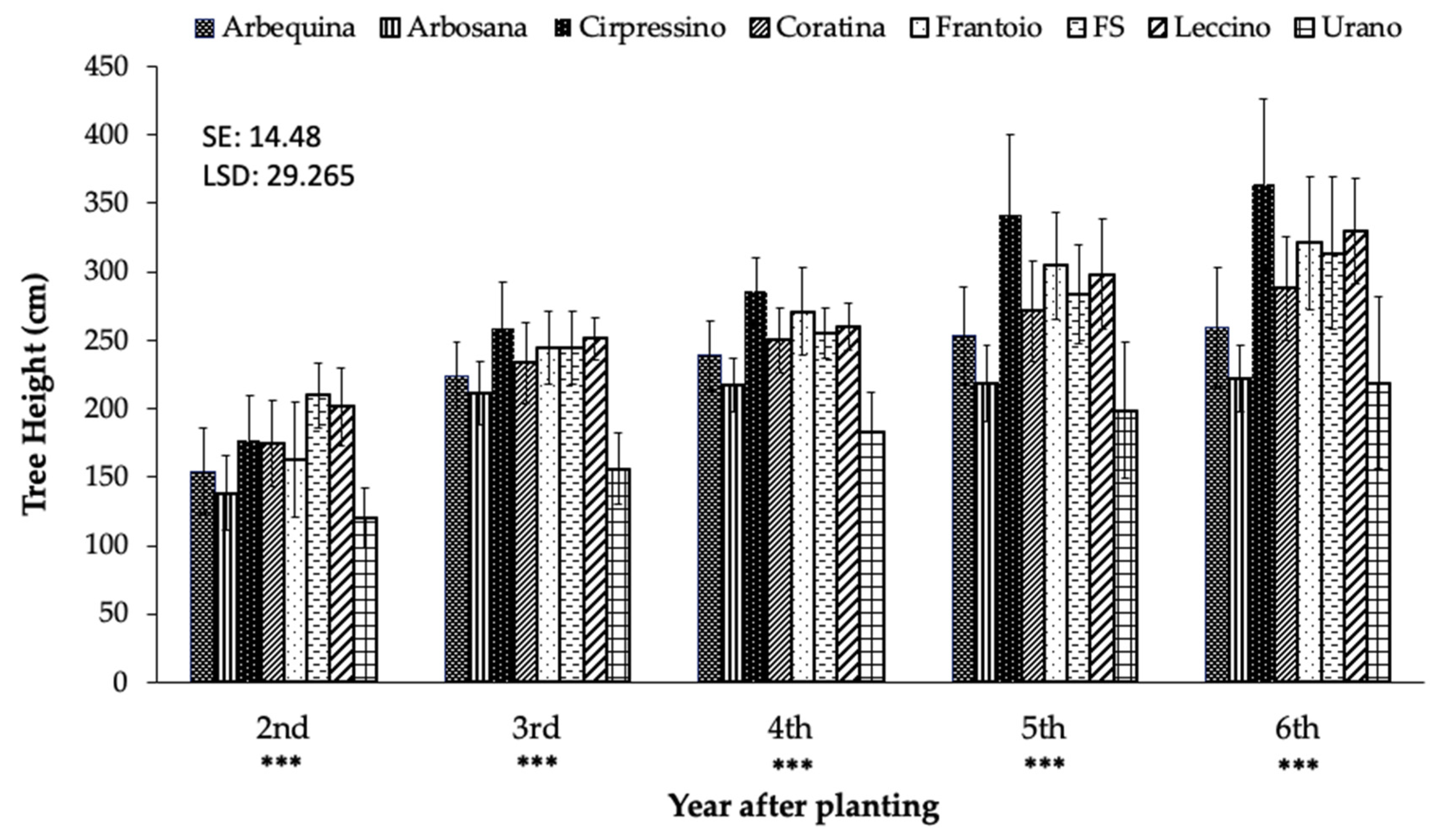
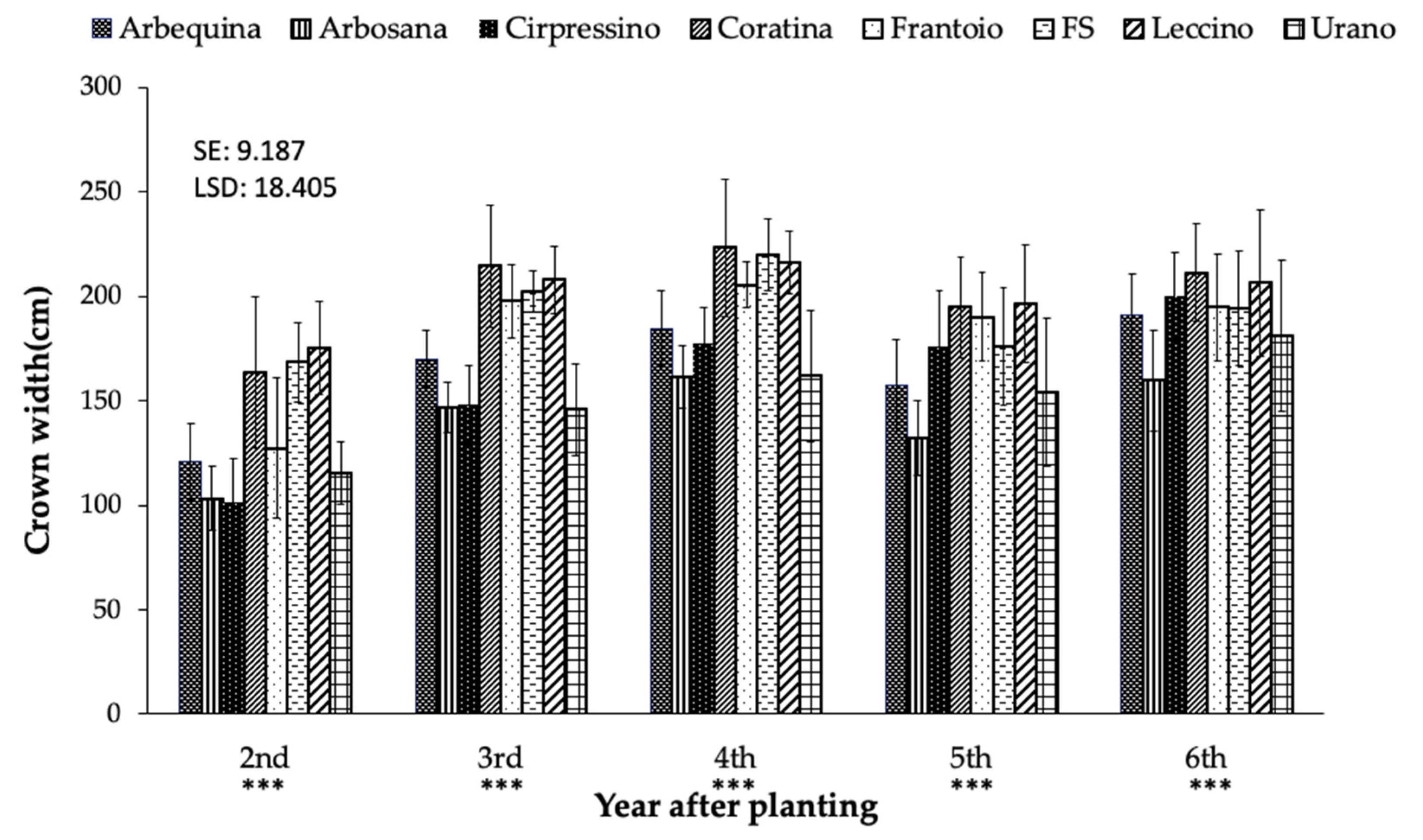

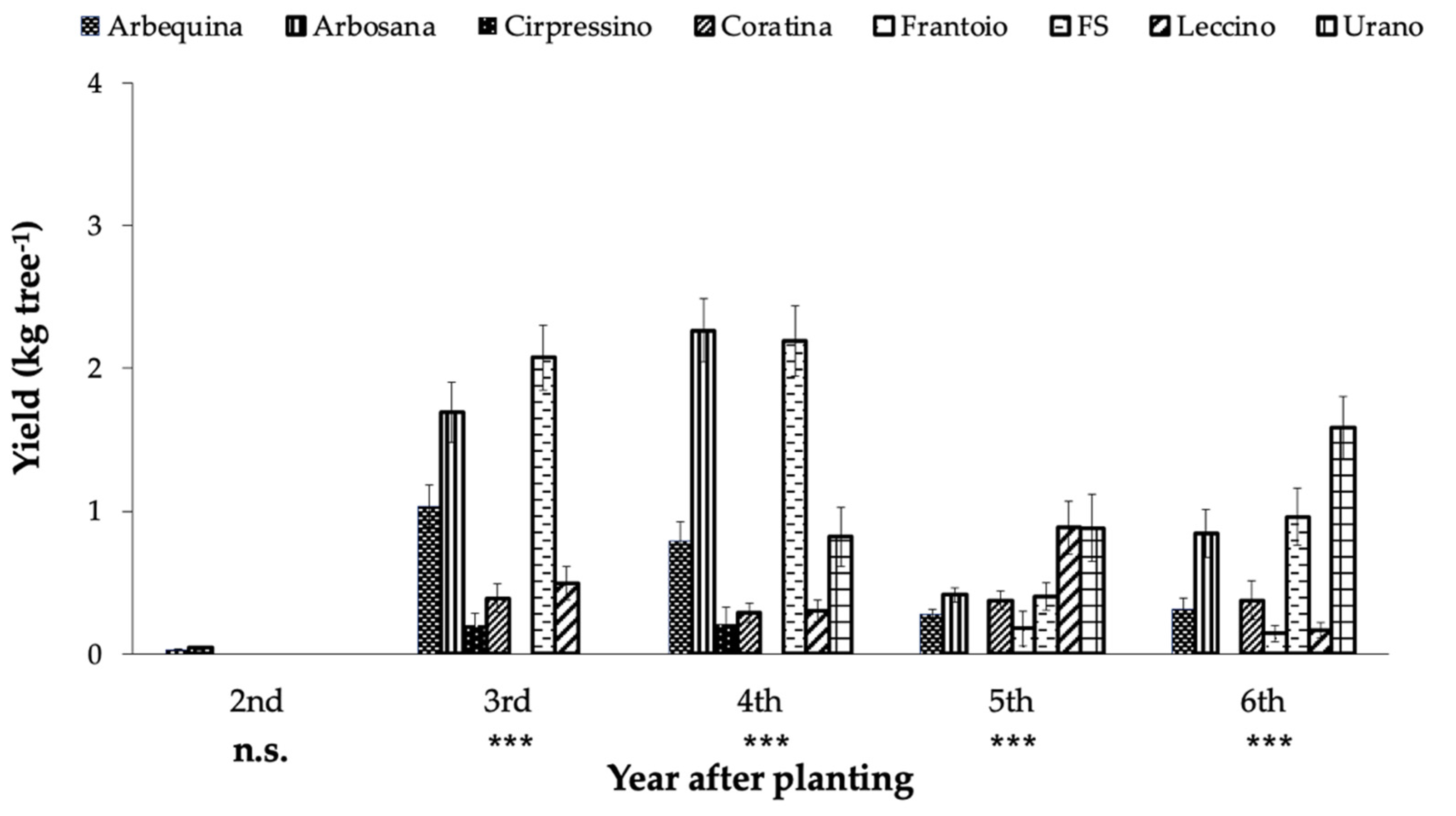
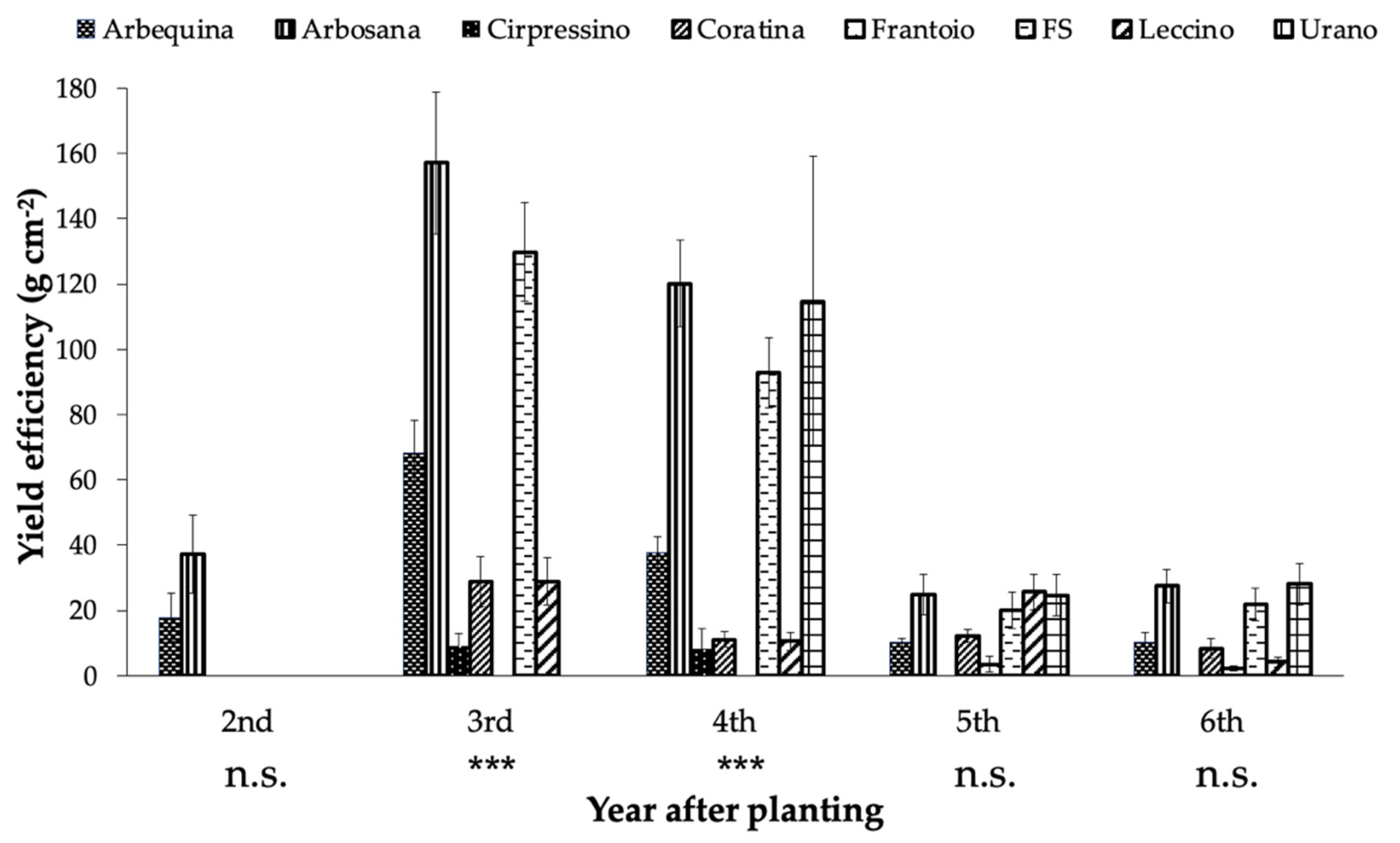
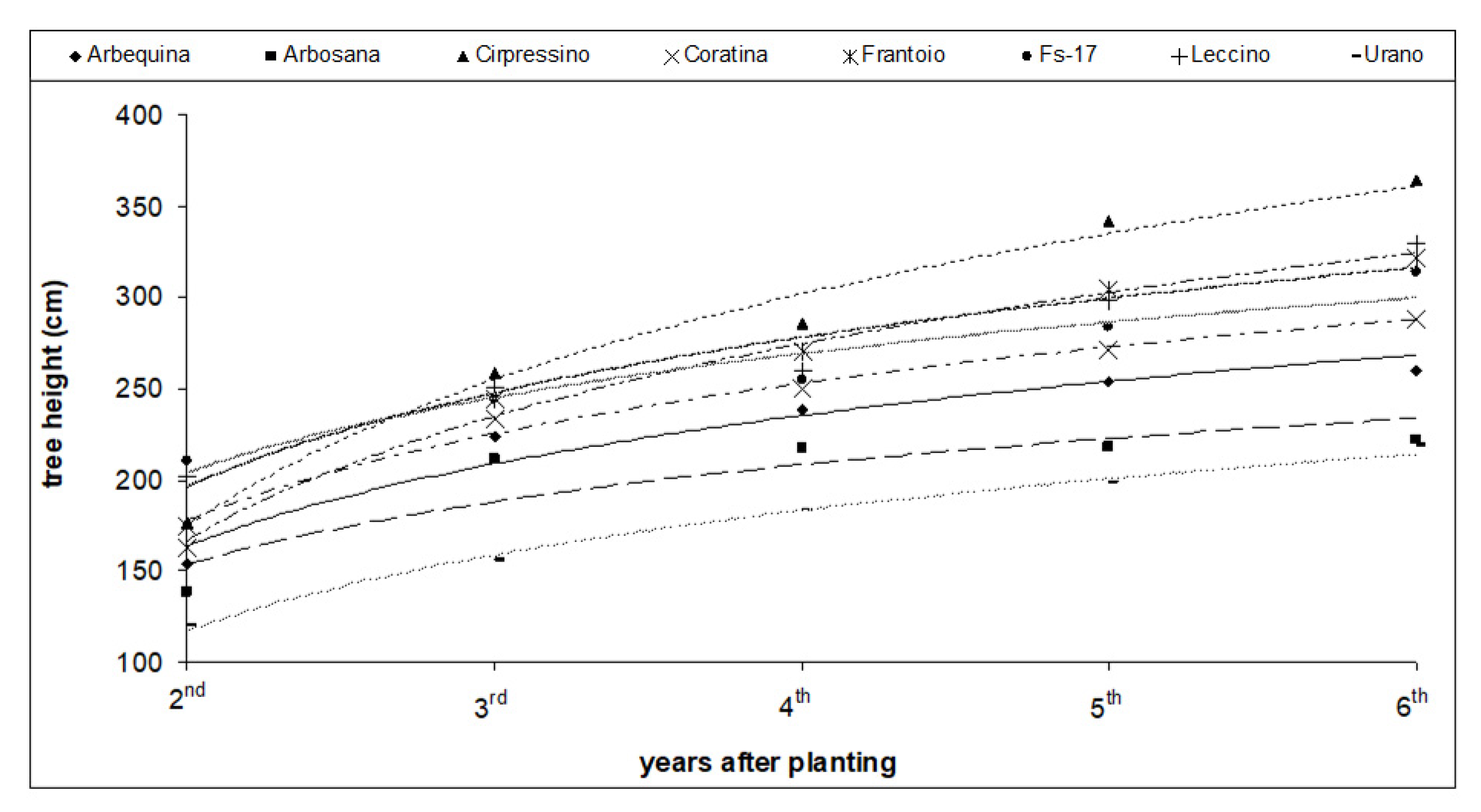
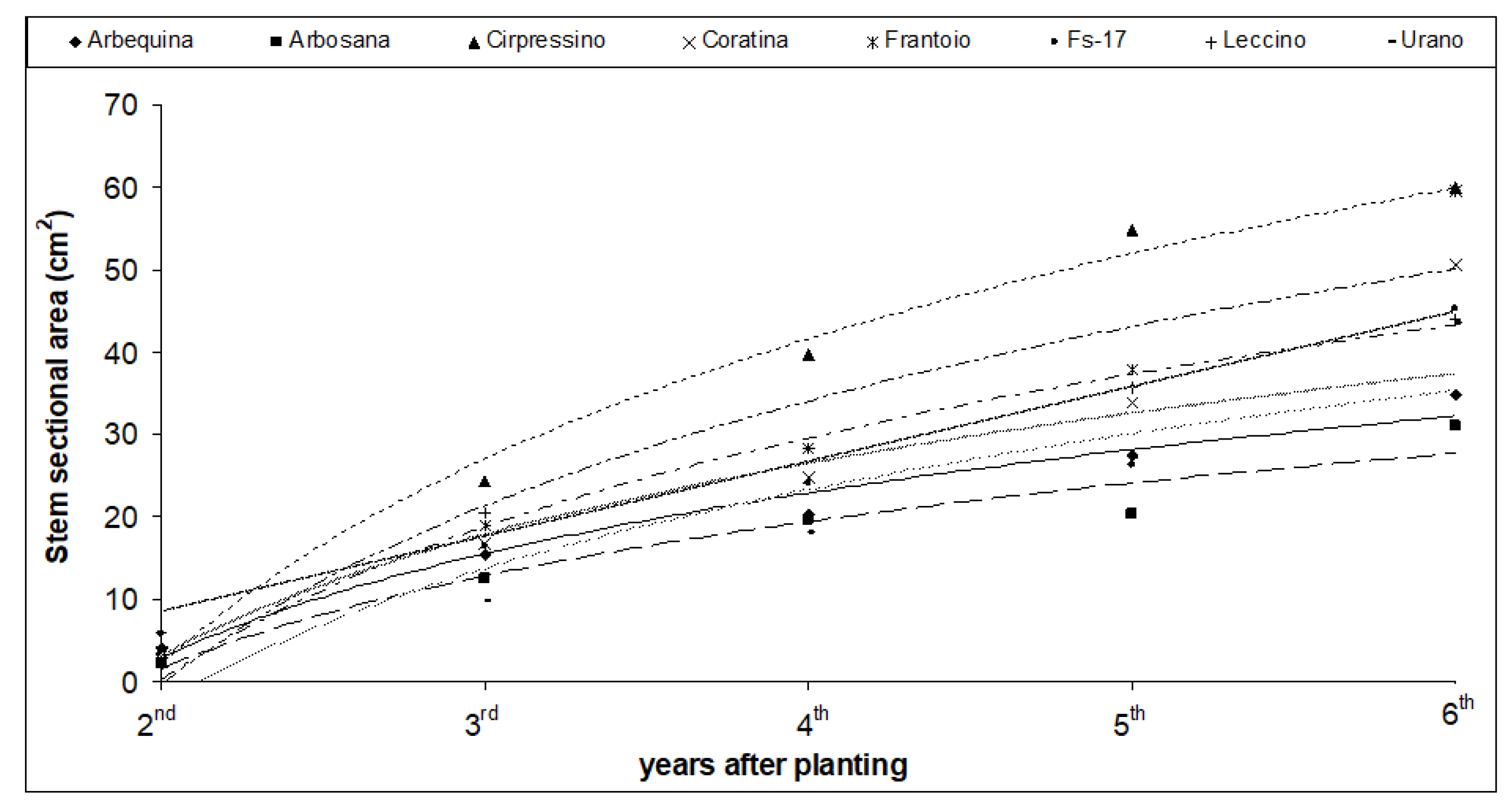
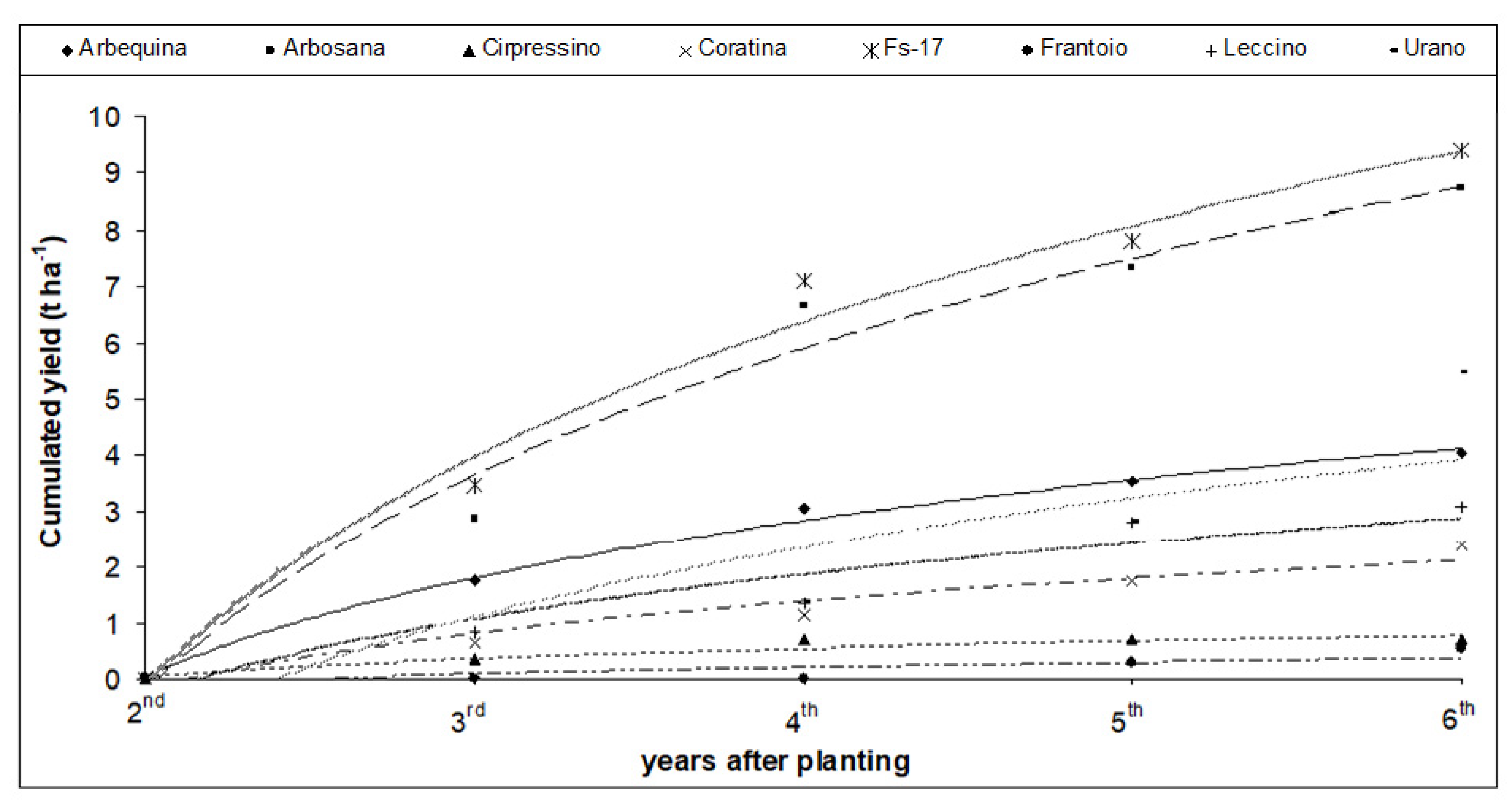
| Source of Variation | Tree Height (H, cm) | Crown Width (W, cm) | Stem Sectional Area (A, cm2) | |
|---|---|---|---|---|
| Year (Y) | *** | *** | *** | |
| 2nd year | 167.48 e | 134.31 d | 3.880 e | |
| 3rd year | 228.04 d | 179.11 b | 16.804 d | |
| 4th year | 245.06 c | 193.68 a | 25.374 c | |
| 5th year | 271.29 b | 171.29 c | 32.965 b | |
| 6th year | 289.68 a | 192.27 a | 46.062 a | |
| Cultivar (cv) | *** | *** | ** | |
| Arbequina | 226.10 c | 164.77 c | 20.347 bc | |
| Arbosana | 201.35 d | 140.60 d | 17.134 c | |
| Cipressino | 285.53 a | 160.61 c | 36.531 a | |
| Coratina | 243.50 bc | 201.43 a | 25.869 bc | |
| Frantoio | 260.77 ab | 181.80 b | 29.654 ab | |
| Fs-17 | 261.77 ab | 192.00 ab | 23.617 bc | |
| Leccino | 268.13 ab | 200.40 a | 26.915 bc | |
| Urano | 175.33 e | 151.47 cd | 20.069 bc | |
| Y × cv | *** | *** | *** | |
| Tree Height (H, cm) | Crown Width (W, cm) | Stem Sectional Area (A, cm2) | |
|---|---|---|---|
| H | 1.000 | 0.71 *** | 0.88 *** |
| W | 0.71 *** | 1.000 | 0.58 *** |
| A | 0.58 *** | 0.58 *** | 1.000 |
| Source of Variation | Yield (kg tree−1) | Yield Efficiency (g cm−2) | |
|---|---|---|---|
| Year (Y) | *** | *** | |
| 2nd year | 0.009 a | 6.896 a | |
| 3rd year | 0.736 bc | 52.737 b | |
| 4th year | 0.859 d | 49.438 d | |
| 5th year | 0.427 b | 15.151 b | |
| 6th year | 0.548 c | 12.811 c | |
| Cultivar (cv) | *** | *** | |
| Arbequina | 0.488 a | 28.83 a | |
| Arbosana | 1.051 b | 73.34 b | |
| Cipressino | 0.082 c | 3.50 c | |
| Coratina | 0.287 d | 12.13 d | |
| Frantoio | 0.065 c | 1.13 c | |
| Fs-17 | 1.126 a | 52.93 a | |
| Leccino | 0.370 d | 13.91 d | |
| Urano | 0.657 d | 33.49 d | |
| Cultivar | Tree Height (H) | Pseudo-R2 |
|---|---|---|
| Arbequina | 0.575 | |
| Arbosana | 0.632 | |
| Coratina | 0.595 | |
| Cipressino | 0.399 | |
| Frantoio | 0.681 | |
| Leccino | 0.671 | |
| Urano | 0.419 | |
| Stem sectional Area (A) | ||
| Arbequina | 0.781 | |
| Arbosana | 0.747 | |
| Cipressino | 0.756 | |
| Leccino | 0.758 | |
| Cumulated Yield (CY) | ||
| Arbequina | 0.505 | |
| Arbosana | 0.585 | |
| Cipressino | 0.061 | |
| Fs-17 | 0.567 | |
| Leccino | 0.323 |
| Cultivar | Tree Height | Stem Sectional Area | Cumulated Yield | |||
|---|---|---|---|---|---|---|
| Fs-17 vs. Arbequina | -- | -- | 3.8× 10−14 | *** | ||
| Fs-17 vs. Arbosana | -- | -- | 3.6× 10−1 | n.s. | ||
| Leccino vs. Arbequina | 4.3 × 10−25 | *** | 5.3 × 10−96 | *** | 2.0× 10−52 | *** |
| Leccino vs. Arbosana | 2.2 × 10−61 | *** | -- | 2.9× 10−30 | *** | |
| Fs-17 vs. Leccino | -- | -- | 2.0× 10−18 | *** | ||
Publisher’s Note: MDPI stays neutral with regard to jurisdictional claims in published maps and institutional affiliations. |
© 2022 by the authors. Licensee MDPI, Basel, Switzerland. This article is an open access article distributed under the terms and conditions of the Creative Commons Attribution (CC BY) license (https://creativecommons.org/licenses/by/4.0/).
Share and Cite
Camposeo, S.; Stellacci, A.M.; Romero Trigueros, C.; Alhajj Ali, S.; Vivaldi, G.A. Different Suitability of Olive Cultivars Resistant to Xylella fastidiosa to the Super-Intensive Planting System. Agronomy 2022, 12, 3157. https://doi.org/10.3390/agronomy12123157
Camposeo S, Stellacci AM, Romero Trigueros C, Alhajj Ali S, Vivaldi GA. Different Suitability of Olive Cultivars Resistant to Xylella fastidiosa to the Super-Intensive Planting System. Agronomy. 2022; 12(12):3157. https://doi.org/10.3390/agronomy12123157
Chicago/Turabian StyleCamposeo, Salvatore, Anna Maria Stellacci, Cristina Romero Trigueros, Salem Alhajj Ali, and Gaetano Alessandro Vivaldi. 2022. "Different Suitability of Olive Cultivars Resistant to Xylella fastidiosa to the Super-Intensive Planting System" Agronomy 12, no. 12: 3157. https://doi.org/10.3390/agronomy12123157
APA StyleCamposeo, S., Stellacci, A. M., Romero Trigueros, C., Alhajj Ali, S., & Vivaldi, G. A. (2022). Different Suitability of Olive Cultivars Resistant to Xylella fastidiosa to the Super-Intensive Planting System. Agronomy, 12(12), 3157. https://doi.org/10.3390/agronomy12123157







